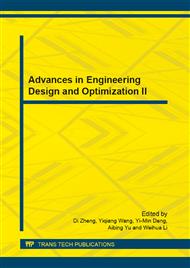p.306
p.311
p.315
p.320
p.324
p.329
p.333
p.339
p.343
Surrogate-Assisted Evolutionary Optimizers for Multiobjective Design of a Torque Arm Structure
Abstract:
This paper presents two surrogate-assisted optimization strategies for structural constrained multiobjective optimization. The optimization strategies are based on hybridization of multiobjective population-based incremental learning (MOPBIL) and radial-basis function (RBF) interpolation. The first strategy uses MOPBIL for generating training points while the second strategy uses a Latin hypercube sampling (LHS) technique. The design case study is the shape and sizing design of a torque arm structure. A design problem is set to minimize structural mass and displacement while constraints include stresses due to three different load cases. Structural analysis is carried out by means of a finite element approach. The design problem is then tackled by the proposed surrogate-assisted design strategies. Numerical results show that the use of MOPBIL for generating training points is superior to the use of LHS based on a hypervolume indicator and root mean square error (RMSE).
Info:
Periodical:
Pages:
324-328
Citation:
Online since:
September 2011
Authors:
Price:
Сopyright:
© 2012 Trans Tech Publications Ltd. All Rights Reserved
Share:
Citation:


